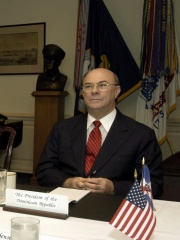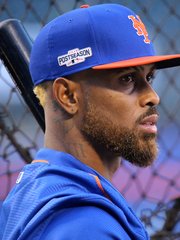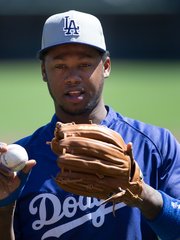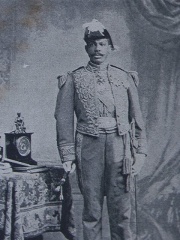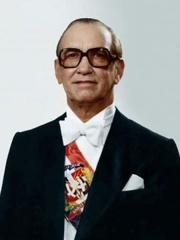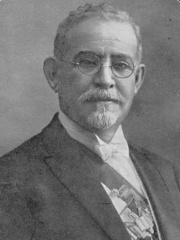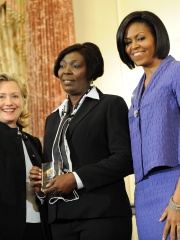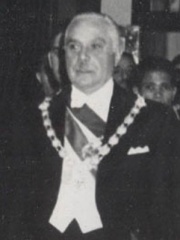
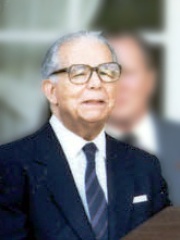
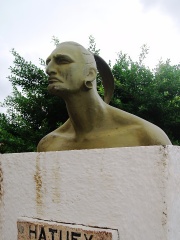
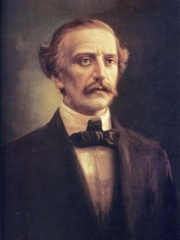
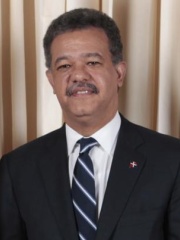
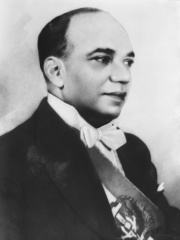
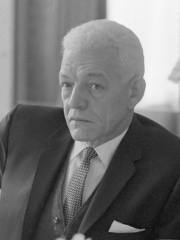
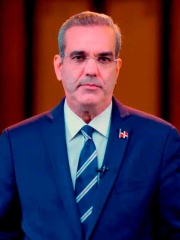
The Most Famous
POLITICIANS from Dominican Republic
This page contains a list of the greatest Dominican Politicians. The pantheon dataset contains 19,576 Politicians, 18 of which were born in Dominican Republic. This makes Dominican Republic the birth place of the 115th most number of Politicians behind Benin, and Guinea.
Top 10
The following people are considered by Pantheon to be the top 10 most legendary Dominican Politicians of all time. This list of famous Dominican Politicians is sorted by HPI (Historical Popularity Index), a metric that aggregates information on a biography's online popularity. Visit the rankings page to view the entire list of Dominican Politicians.

1. Rafael Trujillo (1891 - 1961)
With an HPI of 73.10, Rafael Trujillo is the most famous Dominican Politician. His biography has been translated into 57 different languages on wikipedia.
Rafael Leónidas Trujillo Molina ( troo-HEE-yoh; Spanish: [rafaˈel tɾuˈxiʝo]; 24 October 1891 – 30 May 1961), nicknamed "El Jefe" (Spanish: [el ˈxefe]; lit. 'The Boss'), was a Dominican military officer and dictator who ruled the Dominican Republic from August 1930 until his assassination in May 1961. He was the 36th and 39th president from 1930 to 1938 and again from 1942 to 1952. He also served as the first generalissimo, the de facto most powerful position in the country at the time from 1930 until his assassination. Under that position, Trujillo served under figurehead presidents. Trujillo's 31-year rule, the Trujillo Era (Spanish: El Trujillato or La Era de Trujillo), was one of the longest for a non-royal leader in the world, and centered around a personality cult of the ruling family. It was also one of the most brutal; Trujillo's security forces, including the infamous SIM, were responsible for many murders. According to Luisa de Peña Díaz, director of the Memorial Museum of Dominican Resistance, there were 50,000 victims under Trujillo's regime, including 25,000 deaths and disappearances. In 1937, 17,000 to 35,000 Haitians were killed by the Dominican Army under Trujillo's orders in the infamous Parsley massacre, which continues to affect Dominican-Haitian relations to this day. During his long rule, the Trujillo government's extensive use of state terrorism was prolific even beyond national borders, including the attempted assassination of Venezuelan president Rómulo Betancourt in 1960, the abduction and disappearance in New York City of the Basque exile Jesús Galíndez in 1956, and the murder of Spanish writer José Almoina in Mexico, also in 1960. These acts, particularly the presumed murder of Galíndez, a naturalized US citizen, the attempted murder of Betancourt, a staunch critic of Trujillo, and the murder of the Mirabal sisters, who were among his most notable opponents, in 1960, eroded relations between the Dominican Republic and the international community and ushered in OAS sanctions and economic and military assistance to Dominican opposition forces. After this momentous year, large segments of the Dominican establishment, including the military, turned against him. On 30 May 1961, Trujillo was assassinated by a group of conspirators led by general Antonio Imbert Barrera. In the immediate aftermath, Trujillo's son Ramfis took temporary control of the country, executing most of the conspirators. By November 1961, the Trujillo family was pressured into exile by the titular president Joaquín Balaguer, who introduced reforms to open up the regime. The murder ushered in civil strife which concluded with the Dominican Civil War and a US-OAS intervention, eventually stabilised under a multi-party system in 1966. The Trujillo era unfolded in Dominican Republic of the Caribbean environment particularly susceptible to dictators. In the countries of the Caribbean Basin alone, his dictatorship overlapped with those in Cuba, Nicaragua, Guatemala, El Salvador, Honduras, Venezuela and Haiti. In perspective, the Trujillo dictatorship has been judged more prominent and more brutal than its contemporaries. Trujillo remains a polarizing figure in the Dominican Republic, as the sheer longevity of his rule makes a detached evaluation difficult. While his supporters credit him for bringing long-term stability, economic growth and prosperity, doubling life expectancy of average Dominicans and multiplying the GDP, critics denounce the heavy-handed and violent nature of his regime, including the murder of tens of thousands, and xenophobia towards Haitians, as well as the Trujillo family's nepotism, widespread corruption and looting of the country's natural and economic resources.

2. Joaquín Balaguer (1906 - 2002)
With an HPI of 64.98, Joaquín Balaguer is the 2nd most famous Dominican Politician. His biography has been translated into 35 different languages.
Joaquín Antonio Balaguer Ricardo (1 September 1906 – 14 July 2002) was a Dominican politician, scholar, writer, and lawyer who was the 41st, 45th and 49th president of the Dominican Republic serving three non-consecutive terms from 1960 to 1962, 1966 to 1978, and 1986 to 1996. He previously served as the 24th vice president under President Héctor Trujillo from 1957 to 1960. His enigmatic, secretive personality was inherited from the Trujillo era, as well as his desire to perpetuate himself in power through rigged elections and widespread human rights violations, and he was considered to be a caudillo. According to Luisa de Peña Díaz, director of the Memorial Museum of Dominican Resistance, between 1966 and 1978, 11,000 people were tortured, imprisoned, forcibly disappeared or killed under his regime. This includes 1,200 political killings. Nevertheless, Balaguer was also considered to be instrumental in the liberalization of the Dominican government, and his time as leader of the Dominican Republic saw major changes such as legalized political activities, surprise army promotions and demotions, promoting health and education improvements and instituting modest land reforms.

3. Hatuey (1478 - 1512)
With an HPI of 63.57, Hatuey is the 3rd most famous Dominican Politician. His biography has been translated into 23 different languages.
Hatuey (), also Hatüey (; died 2 February 1512), was a Taíno Cacique (chief) of the Hispaniolan cacicazgo of Guanaba (in present-day La Gonave, Haiti). He lived from the late 15th until the early 16th century. Chief Hatuey and many of his tribesmen travelled from present-day La Gonave by canoe to Cuba to warn the Taíno in Cuba about the Spaniards that were arriving to conquer the island. He later attained legendary status for leading a group of natives in a fight against the invasion of the Spaniards, thus becoming one of the first fighters against Spanish colonialism in the New World. He is celebrated as "Cuba's first national hero."

4. Juan Pablo Duarte (1813 - 1876)
With an HPI of 63.53, Juan Pablo Duarte is the 4th most famous Dominican Politician. His biography has been translated into 25 different languages.
Juan Pablo Duarte y Díez (January 26, 1813 – July 15, 1876) was a Dominican military leader, writer, activist, and nationalist politician who was the foremost of the Founding Fathers of the Dominican Republic and bears the title of Father of the Nation. As one of the most celebrated figures in Dominican history, Duarte is considered a folk hero and revolutionary visionary in the modern Dominican Republic, who, along with military generals Matías Ramón Mella and Francisco del Rosario Sánchez, organized and promoted La Trinitaria, a secret society that eventually led to the Dominican revolt and independence from Haitian rule in 1844 and the start of the Dominican War of Independence.
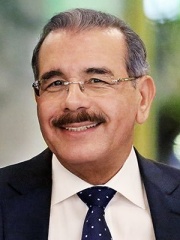
5. Danilo Medina (b. 1951)
With an HPI of 61.52, Danilo Medina is the 5th most famous Dominican Politician. His biography has been translated into 42 different languages.
Danilo Medina Sánchez (Latin American Spanish pronunciation: [daˈnilo meˈðina ˈsantʃes]; born 10 November 1951) is a Dominican politician who was President of the Dominican Republic from 2012 to 2020. Medina previously served as Chief of Staff to the President of the Dominican Republic from 1996 to 1999 and from 2004 to 2006, and is a member of the Dominican Liberation Party (PLD). He won the May 2012 Dominican presidential election, defeating Hipòlito Mejía with 51% of the votes. On 15 May 2016, Danilo Medina leading a coalition of parties won the 2016 Dominican presidential election, defeating the leader of the opposition and PRM candidate Luis Abinader with 61.8% of the votes, the highest percentage received by a president elected in free elections since 1924 when Horacio Vásquez won the presidency with 69.8% of the ballots—surpassing Juan Bosch's record of 59.5% obtained in 1962, and Leonel Fernández's 57.1% of the votes obtained in 2004. Medina's second term has been characterized as humane, transparent and goal-driven by its supporters. With a penchant for performing weekly visits to impoverished rural sections of the country, President Medina finished his second term with a 65% approval rate. However, during his second term there were attempts to seek a third term which was frustrated after a call from the United States Secretary of State Mike Pompeo. Medina's family, including two of his brothers, are currently being investigated under allegations of corruption, involving traffic of influence by which they benefited under Medina presidency, obtaining multiple contracts and business with the State. As of November 2020, the investigation process had entered a new phase following the arrests of two of Medina's brothers.

6. Leonel Fernández (b. 1953)
With an HPI of 61.28, Leonel Fernández is the 6th most famous Dominican Politician. His biography has been translated into 45 different languages.
Leonel Antonio Fernández Reyna () (born 26 December 1953) is a Dominican lawyer, academic, and was the 50th and 52nd President of the Dominican Republic from 1996 to 2000 and from 2004 to 2012. From 2016 until 2020, he was the President of the EU–LAC Foundation. Fernández became the first elected president of the Dominican Republic under his political party, the Dominican Liberation Party (Partido de la Liberación Dominicana, or PLD), although party founder Juan Bosch was also sworn in as president in 1963 after the first democratic elections held in roughly four decades in the country. Fernández's administrations have focused much on technological and infrastructural development and macroeconomic and monetary stability. He has served as the party president of the Dominican Liberation Party from 2001 until his resignation on 20 October 2019. He later founded the People's Force and nominated himself as its party's presidential nominee. He is a native of Villa Juana, Distrito Nacional and lived for much of his childhood and early adulthood in New York City. Leonel Fernández is a former the President of the World Federation of United Nations Associations (2018-2022) and a member of the Inter-American Dialogue.

7. Héctor Trujillo (1908 - 2002)
With an HPI of 59.77, Héctor Trujillo is the 7th most famous Dominican Politician. His biography has been translated into 19 different languages.
Héctor Bienvenido "Negro" Trujillo Molina (6 April 1908 – 19 October 2002) was a Dominican politician and general who was the 40th president of the Dominican Republic from 1952 until 1960. He was the brother and puppet of former president and dictator Rafael Trujillo, the person who held the real power behind-the-scenes.

8. Juan Bosch (1909 - 2001)
With an HPI of 59.67, Juan Bosch is the 8th most famous Dominican Politician. His biography has been translated into 30 different languages.
Juan Emilio Bosch y Gaviño (30 June 1909 – 1 November 2001), also known as El Profesor (Spanish for the Teacher), was a Dominican politician, historian, writer, essayist, educator, and the first democratically elected president of the Dominican Republic for seven months in 1963. Juan Bosch was a leading opponent against the dictatorial regime of Rafael Trujillo, spending over two decaes as the leader of the Dominican opposition while in exile. In 1939, he helped found the Dominican Revolutionary Party (PRD), and returned to the Dominican Republic months after Trijillo's assasination in 1961, winning the first free elections in decades. In 1973, he founded the Dominican Liberation Party (PLD). He is remembered as an honest politician and regarded as one of the most prominent short-story writers in Dominican literature.

9. Luis Abinader (b. 1967)
With an HPI of 59.54, Luis Abinader is the 9th most famous Dominican Politician. His biography has been translated into 38 different languages.
Luis Rodolfo Abinader Corona (Spanish pronunciation: [ˈlwis roˈðolfo aβinaˈðeɾ koˈɾona]; born 12 July 1967) is a Dominican economist, businessman, and politician who has served as the 54th president of the Dominican Republic since 2020. He was the Modern Revolutionary Party candidate for President of the Dominican Republic in the 2016, 2020, and 2024 general elections. Before becoming president, Abinader was the general manager of Grupo Abicor, a business consortium started by his father, José Rafael Abinader, a former senator and finance minister. Grupo Abicor includes a real estate and construction company focused mainly on the tourism industry, a concrete factory, and a private university. As revealed by the Pandora Papers, Abinader also owns several offshore companies. Abinader was proclaimed as Latin America's richest president by Bloomberg Línea in 2022. His first 100 days in office, in a context of mitigation of the Covid-19 pandemic, were rated positively by some sectors of society such as social and business actors, who positively valued the measures adopted during the health crisis. In the international arena, he has been participating in regional forums and discussions with think tanks in the capital of the United States, such as the Council of the Americas and the Woodrow Wilson International Center for Scholars. In November 2020, during a high-level discussion he had with CNN columnist political strategist Geovanny Vicente at the DC Dialogues at New York University, he reviewed the achievements made in his first 100 days in office and noted that the Dominican Republic, in addition to being the fastest growing economy in Latin America, is also ready to receive investments. Abinader was re-elected to a second term as president in the 2024 Dominican Republic general election. In his victory speech, Abinader said that the "changes that we've made are going to be irreversible", and that the "best is yet to come".
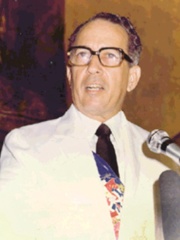
10. Salvador Jorge Blanco (1926 - 2010)
With an HPI of 59.39, Salvador Jorge Blanco is the 10th most famous Dominican Politician. His biography has been translated into 35 different languages.
José Salvador Omar Jorge Blanco (5 July 1926 – 26 December 2010) was a Dominican politician, lawyer and writer who served as the 48th president of the Dominican Republic from 1982 to 1986. He was a Senator running for the PRD party. He started his political career as a Committee Secretary for the Unión Cívica de Santiago in 1963 and joined the PRD in 1964.
People
Pantheon has 18 people classified as Dominican politicians born between 1478 and 1983. Of these 18, 6 (33.33%) of them are still alive today. The most famous living Dominican politicians include Danilo Medina, Leonel Fernández, and Luis Abinader. The most famous deceased Dominican politicians include Rafael Trujillo, Joaquín Balaguer, and Hatuey. As of April 2024, 2 new Dominican politicians have been added to Pantheon including José Reyes, and Hanley Ramírez.
Living Dominican Politicians
Go to all RankingsDanilo Medina
1951 - Present
HPI: 61.52
Leonel Fernández
1953 - Present
HPI: 61.28
Luis Abinader
1967 - Present
HPI: 59.54
Hipólito Mejía
1941 - Present
HPI: 58.76
José Reyes
1983 - Present
HPI: 38.36
Hanley Ramírez
1983 - Present
HPI: 35.77
Deceased Dominican Politicians
Go to all RankingsRafael Trujillo
1891 - 1961
HPI: 73.10
Joaquín Balaguer
1906 - 2002
HPI: 64.98
Hatuey
1478 - 1512
HPI: 63.57
Juan Pablo Duarte
1813 - 1876
HPI: 63.53
Héctor Trujillo
1908 - 2002
HPI: 59.77
Juan Bosch
1909 - 2001
HPI: 59.67
Salvador Jorge Blanco
1926 - 2010
HPI: 59.39
Ulises Heureaux
1845 - 1899
HPI: 58.11
Antonio Guzmán Fernández
1911 - 1982
HPI: 57.90
Buenaventura Báez
1812 - 1884
HPI: 57.08
Horacio Vásquez
1860 - 1936
HPI: 56.60
Sonia Pierre
1963 - 2011
HPI: 47.10
Newly Added Dominican Politicians (2025)
Go to all RankingsOverlapping Lives
Which Politicians were alive at the same time? This visualization shows the lifespans of the 11 most globally memorable Politicians since 1700.

